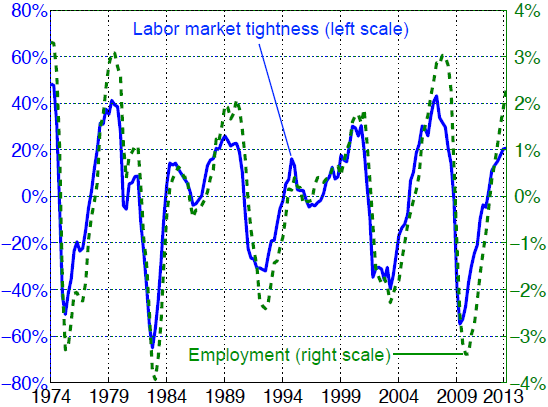What causes persistently high unemployment?

Stay up to date:
Hyperconnectivity
For the five years from December 2008 to November 2013, the US unemployment rate remained above 7%, peaking at 10% in October 2009. This period of high unemployment is not well understood. Macroeconomists have proposed a number of explanations for the extent and persistence of unemployment during the period, including:
- High mismatch caused by major shocks to the financial and housing sectors,
- Low search effort from unemployed workers triggered by long extensions of unemployment insurance benefits, and
- Low aggregate demand caused by a sudden need to repay debts or pessimism,
but no consensus has been reached.
In our opinion this lack of consensus is due to a gap in macroeconomic theory: we do not have a model that is rich enough to account for the many factors driving unemployment – including aggregate demand – and simple enough to lend itself to pencil-and-paper analysis.
The well-known fix-price model of Barro and Grossman (1971), which was the first formal representation of a Keynesian world with rigid prices and wages, was a promising candidate because it captured the link between aggregate demand and unemployment. That model relied on disequilibrium, whereby supply can exceed demand because prices do not adjust. The Barro-Grossman model fell out of favour, perhaps because it lacked tractability, or because of the development of equilibrium business-cycle models such as the real-business-cycle model of Kydland and Prescott (1982).
In Michaillat and Saez (2014), we develop a new model of unemployment fluctuations to inspect the mechanisms behind unemployment fluctuations. The model can be seen as an equilibrium version of the Barro-Grossman model. It retains the architecture of the Barro-Grossman model but replaces the disequilibrium framework on the product and labour markets with an equilibrium matching framework.
Imagine a world in which all firms are restaurants and all workers are cooks and waiters. Restaurants hire cooks and waiters on the labour market and sell meals on the product market. The product and labour markets have two features in common.
- First, not all workers find employment in restaurants, and not all tables are used by customers. Thus, workers are unemployed some of the time, and, since restaurants do not always operate at full capacity, restaurants’ employees remain idle some of the time.
- Second, restaurants cannot always immediately fill a vacancy – customers sometimes need to queue before sitting at a table. The economic variable that determines how easy it is for workers to find a job and how difficult it is for a restaurant to fill a vacancy is the labour market tightness. The economic variable that determines how busy restaurants’ employees are and how difficult it is for customers to get a table is the product market tightness.
In the world of restaurants, both meal prices and product market tightness can adjust to equilibrate supply and demand for meals. Of course, high meal prices stimulate supply but discourage demand for meals. In addition, high product market tightness stimulates supply of meals by ensuring that most restaurant tables are full; but it discourages demand for meals by forcing customers to queue for tables. The same mechanism is at play on the labour market, where both wages and labour market tightness adjust to equilibrate labour supply and demand.
When meal prices are not fully flexible, the aggregate demand for meals will propagate to the labour market. Higher aggregate demand increases the share of tables that are occupied in restaurants, which makes restaurants’ employees busier. Since busier employees are more profitable to restaurants, restaurants hire more employees when aggregate demand increases, in turn reducing the unemployment rate of cooks and waiters.
There is no presumption that only market tightnesses or only prices adjust to equilibrate supply and demand. If product and labour market tightness remain constant, the equilibrium is reached by price adjustment, and the restaurant world will look like a textbook Walrasian world with flexible prices. But if prices are rigid, the equilibrium is reached by adjustment of product and labour market tightness, and the restaurant world will look like the fix-price world of Barro and Grossman.
Figure 1.
Notes: The significant fluctuations of product market tightness (left panel) and labour market tightness (right panel) indicate price and real wage rigidity. Product market tightness is proxied by the utilization of employed workers. Labour market tightness is measured by the ratio of vacancies posted by firms to unemployment.
In the data we observe that product and labour market tightnesses fluctuate significantly, suggesting that price and real wages are not fully flexible over the business cycle. A simple way to understand the argument is to think again about restaurants. Restaurant prices usually remain constant from morning to night while demand fluctuates significantly over the course of the day. As a result, restaurants are much busier at meal times than between them. In contrast, if prices were flexible, a restaurant would be able to keep the rate of occupation of its tables constant by adjusting prices up and down when demand increases and decreases. Figure 1 depicts the empirical measures of product and labour market tightnesses. Both measures fluctuate sharply over the business cycle, and in particular, both collapse in 2008 and 2009 during the Great Recession. The implication is that price and real wages are somewhat rigid over the business cycle.
Figure 2.
Notes: The positive correlation of labour market tightness and employment indicates labour demand shocks. Labour market tightness is measured by the ratio of vacancies to unemployment. The y-axes represents percentage deviation from trend.
Figure 1 shows that prices are somewhat rigid in response to macroeconomic shocks. The next step is to ascertain what these shocks are. In the data we observe that employment is positively correlated with labour market tightness, which suggests that unemployment fluctuations are mostly caused by labour demand shocks and not labour supply shocks.
The argument is simple. If restaurants do not want to hire anymore, employment will fall. At the same time, unemployed workers will take longer to find a job, but recruiting will be easier for restaurants that still want to hire; that is, labour market tightness will be low. In sum, a negative labour demand shock leads to falls in both employment and labour market tightness.
If unemployed cooks and waiters reduce their job-search effort, employment will also fall. But it will now be harder for restaurants to recruit; that is, labour market tightness will be high. In sum, a negative labour supply shock leads to a fall in employment but an increase in labour market tightness.
Figure 2 shows that labour market tightness and employment are strongly positively correlated over the business cycle. The implication is that labour market fluctuations are mostly driven by labour demand shocks, and not by labour supply shocks. In particular, labour market tightness and employment fell precipitously in 2008 and 2009 during the Great Recession, pointing to a collapse in labour demand.
Figure 2 shows that labour demand shocks drive labour market fluctuations. The last step is to determine whether these shocks are technology or aggregate demand shocks. In the data we observe that output is positively correlated with product market tightness, which suggests that labour demand shocks mostly reflect aggregate demand shocks and not technology shocks.
To explain the argument, we turn again to the world of restaurants. If the aggregate demand for meals increases, more meals will be sold, and the share of tables that are occupied will increase. Formally, output and product market tightness move in the same direction with demand shocks. In contrast, if restaurants suddenly have access to better technology – for instance microwave ovens that allow them to prepare in meals in only 15 minutes instead of the usual 30 minutes – more meals will also be sold, but the share of tables that are occupied will decrease significantly because customers will wait a shorter time in restaurant queues. Formally, output and product market tightness move in opposite direction with technology shocks.
Figure 3 shows that product market tightness and output are positively correlated over the business cycle. The implication is that labour market fluctuations are mostly driven by aggregate demand shocks and not by technology shocks. In particular, product market tightness fell sharply during the Great Recession in 2009, consistent with a collapse in aggregate demand.
Figure 3.
Notes: The positive correlation of product market tightness and output indicates aggregate demand shocks. Product market tightness is proxied by the utilization of employed workers. The y-axes represent percentage deviation from trend.
Through the lens of our simple model, the empirical evidence suggests that price and real wage are somewhat rigid, and that unemployment fluctuations are mainly driven by aggregate demand shocks.
Published in collaboration with Vox
Authors: Pascal Michaillat, Lecturer in the Department of Economics, LSE and Emmanuel Saez, Professor of Economics and Director of the Center for Equitable Growth, University of California Berkeley
Image: Motorized mannequins hold signs that read “Hire Me” in Toronto May 23, 2014. REUTERS/Mark Blinch
Don't miss any update on this topic
Create a free account and access your personalized content collection with our latest publications and analyses.
License and Republishing
World Economic Forum articles may be republished in accordance with the Creative Commons Attribution-NonCommercial-NoDerivatives 4.0 International Public License, and in accordance with our Terms of Use.
The views expressed in this article are those of the author alone and not the World Economic Forum.
Forum Stories newsletter
Bringing you weekly curated insights and analysis on the global issues that matter.
More on Financial and Monetary SystemsSee all
Veronica Frisancho
July 22, 2025
Jesus Serrano
July 14, 2025
Rebecca Geldard
July 10, 2025
Morgan Camp
July 9, 2025
David Elliott
July 8, 2025








